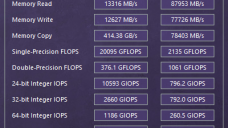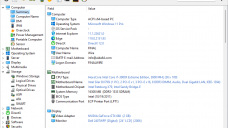FinalWire Announces AIDA64 v8.00
AIDA64 v8.00 introduces a host of powerful new features
Posted | September 15, 2025
- Native 64-bit binaries, new compiler, faster startup and operation: AIDA64 now fully leverages the power of modern 64-bit processors, resulting in a faster, more responsive experience.
- OpenCL support for NVIDIA GeForce RTX 5000 Series GPUs: The new version unlocks GPGPU benchmarks and GPU stress testing for the latest NVIDIA GPUs, allowing users to accurately measure the performance of their hardware. This was not possible with previous 32-bit versions of AIDA64.
- Dynamic DPI scaling (per-monitor DPI awareness): Users with multiple monitors and mixed DPI settings will find AIDA64 much more user-friendly. AIDA64 windows will now automatically and smoothly adapt as they are moved between displays.
- Improved handling of multiple monitors: AIDA64 v8.00 offers a fixed and improved experience for multi-monitor setups, especially when different DPI settings are in use.
- Unicode string handling, improved localization, fixed Windows codepage issues: With full Unicode support, switching between UI languages is now seamless, and the software is no longer reliant on potentially incorrect Windows character encoding settings.
- Windows PE v3.0+ support: AIDA64 can now be used on modern bootable Windows systems (live CDs) like Windows PE v3.0, which were previously incompatible with the 32-bit version of the software.
- SPZIP file format for more compact SensorPanel layouts: The new SPZIP file format uses ZIP compression, resulting in SensorPanel layouts that are typically less than half the size of classic .sensorpanel files. This also allows for easy extraction and modification of individual components within the layout.
Compatibility with previous Windows versions
The move to a modern compiler and native 64-bit binaries has also resulted in a significant shift: AIDA64 v8.00 will no longer support 32-bit Windows versions or Windows XP x64. While this decision was necessary to modernize the software and enable the new features, it marks a clear direction towards supporting the latest operating systems and hardware.
Check legacy compatibility of AIDA64 versions.
Best Practices for Upgrading
Moving to AIDA64 v8.00 is straightforward, but there are a few important steps to follow. Our migration guide
highlights the required adjustments, including copying INI files from the old Program Files (x86) path, ensuring compatibility with new Unicode reports, and verifying system prerequisites.
Online Documentation
We've transitioned from the previous offline user manual to an extended, online version that is always up to date. This new manual offers comprehensive, real-time information and ensures that users have access to the latest guidance and support. By moving to an online format, we can continuously update and improve the content, providing a more efficient and user-friendly experience.
You can reach the Online User Manual here, or by pressing the "F1" key in AIDA64.








